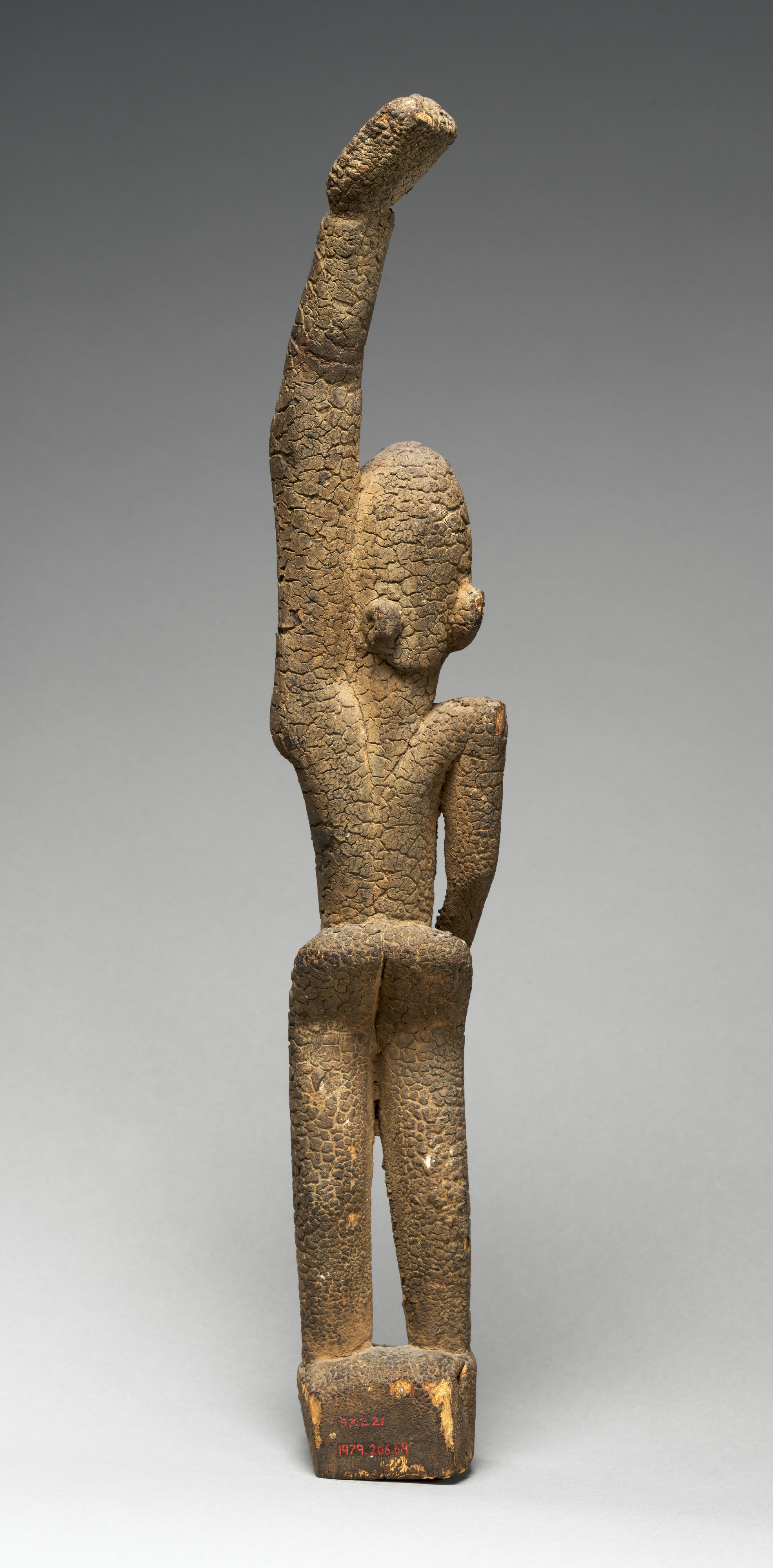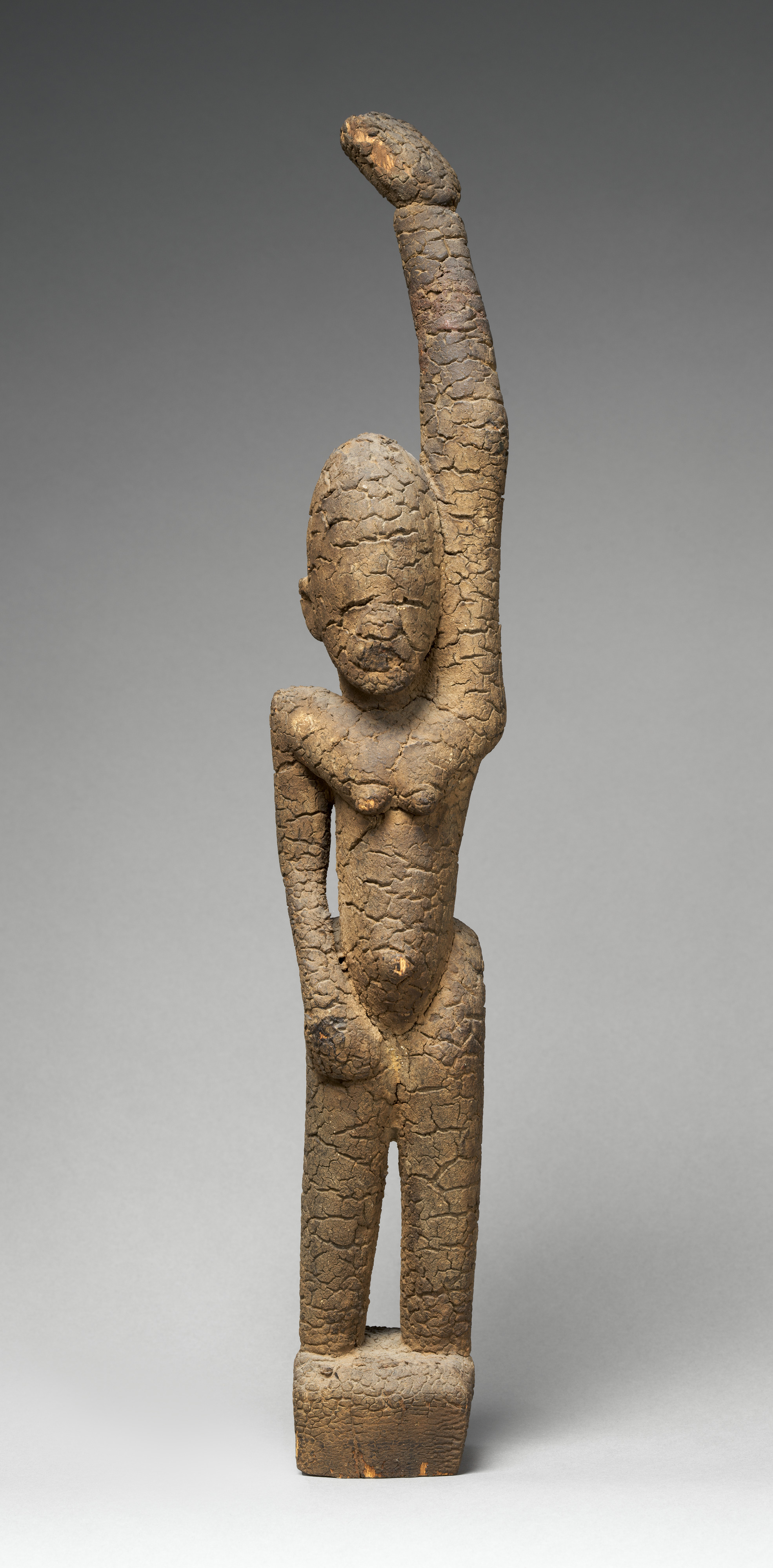Female Figure with Raised Arm
Not on view
This female figure stands erect facing forward with her right hand close to her thigh and her left arm powerfully extending towards the sky. The carver of this intimately scaled figure privileged the body’s volumetric forms. With an economy of lines and planes, the sculptor stylized her physique, underscoring elongated features and rounded surfaces, with some sharper angular transitions particularly evident in profile. The legs, torso and arms are rendered as cylindrical volumes whose facets are modulated to suggest a knee joint, protruding navel, pointed buttocks, and small breasts. Sunken into the base, the feet are presented as one solid mass that heightens the figure’s poise and steadiness. Starting from the pedestal, the succession of vertically oriented lines and forms creates a strong visual tension that culminates in the elongated arm and enlarged hand pointing upwards. In contrast with the sculpture’s forceful upright posture, the left palm is open, delicately arching back as if to graciously accept something from the sky.
This sculpture relates to a corpus of works that scholars have attributed to the Tellem people, who lived in Central Mali between the eleventh and sixteenth century. Ever since Tellem objects were first collected over a century ago, archeologists, art historians, anthropologists and historians have employed different disciplinary lenses to interpret them. Given that most of these were originally found in funerary caves, scholars tend to agree that they were employed in burial functions. In the case of this specific object, the raised arm has often been read as an invocation for rain. Yet, as there is no continuum between the people who created these works and those who now inhabit the region and have offered important clues about the Tellem, further research is needed to understand this extraordinary body of work.
Europeans first became aware of the existence of this culture in 1903. That year the French Lieutenant Louis Desplagnes travelled to Mali, to the high cliffs of Bandiagara 300 meters above the plains, where the Dogon people lived. Desplagnes interviewed members of the Dogon community who indicated some funerary caves that were used by the "Tellem," a local term that translates as "we have found them." According to oral accounts collected by Desplagnes and later confirmed in 1933 by anthropologist Marcel Griaule during his Dakar-Djibouti expedition, the Dogon had arrived at the Bandiagara escarpment in the fifteenth century and found the Tellem population living there. The two populations lived in the same area for about a century until the Tellem disappeared for unknown reasons.
Returning from their missions in the early 1900s and late 1930s, Desplagnes and Griaule each brought back objects from the Tellem caves including clothing, ornaments, kitchen utensils, and ritual pottery. Notable among these objects were ritual artifacts in the form of wood sculptures coated with sacrificial matter composed of millet, animal blood, and other natural fibers. Over time, this became a thick but evenly applied patina, cracked after centuries of dry heat—a feature that has come to define Tellem devotional sculptures.
Following Desplagnes’ and Griaule’s accounts, art dealer and researcher Pierre Langlois travelled to this region in the early 1950s to document Tellem history and art production. In his trips, Langlois collected more objects in the village of Iréli probably including this figure with a raised arm now in the Metropolitan Museum. Langlois’s research resulted in a 1954 exhibition in which he highlighted a Tellem aesthetic that is distinctive and pre-Dogon. In the following decades, some scholars such as William Fagg contested this category, while others such as Rogier Bedaux conducted archaeological excavations in the region providing scientific evidence for the existence of Tellem production predating and overlapping with that of the Dogon. Following Bedaux, Bernard de Grunne produced a close stylistic analysis of Tellem wooden sculptures identifying the dominant features of a Tellem aesthetic within which he proposed three contemporaneous formal styles. Within that classification, sculptures with a raised arm belonged to the "Iréli style," named after the village where these sculptures were originally found. According to Grunne, the raised arm, which is often interpreted as a gesture of prayer for rain, is a motif that originated with the Tellem, and that the Dogon later appropriated (as in the case of the Met’s Male Figure with Raised Arms, 1978.412.322).
Since the first accounts of the early 1900s, scholars have explored different approaches to understanding these sculptures’ aesthetic qualities, historical significance, and social functions. More recently, Carbon 14 analysis of a nearly identical sculpture in the collection of the Quai Branly Museum but currently on display at the Louvre reveals a date of origin between the fifteenth and seventeenth centuries (accession number: 70.1999.7.1). Stylistic correspondences between these two works open up the possibility that the same atelier may have produced both of them.
Giulia Paoletti, 2016
Andrew W. Mellon Postdoctoral Curatorial Fellow in the Department of the Arts of Africa, Oceania and the Americas
Published References
Bernard de Grunne, "La sculpture classique Tellem: essai d'analyse stylistique," Arts d'Afrique noire (Arnouville), no. 88, Winter (1993), p. 28.
Sculptures Afrique Asie Océanie Amériques L'album de l'exposition Musée du Louvre, Pavillon des Sessions, 2000, p. 82.
Art of Oceania, Africa, and the Americas from the Museum of Primitive Art. New York: The Metropolitan Museum of Art, 1969, Fig. 233.
Sculpture from Three African Tribes: Senufo, Baga, Dogon. New York: The Museum of Primitive Art, 1959, Fig.12.
Further Reading
Bedaux, Rogier. "Tellem and Dogon material culture", in African Arts (Los Angeles), 21, 4, (1988), pp.38–45, 91.
Bedaux, Rogier. "Tellem, reconnaissance archéologique d'une culture de l'Ouest africain au Moyen Âge: les appuie-nuque," Journal de la Société des africanistes, 44, 1, (1974), pp.7–42.
Bedaux, Rogier. "Rediscovering the Tellem of Mali," Archaeology, Vol. 35, No. 3 (May/June 1982), pp. 28–34.
Damase, Jacques, Sculpture of the Tellem and the Dogon, Pierre Matisse Gallery 41 E. 57 St., New York, 1960.
Damase, Jacques and Michel Leiris. Sculpture of the Tellem and the Dogon, Hanover Gallery, London, 1959.
Leloup, Héléne. Dogon. Paris: Somogy: Musée du quai Branly, 2011.
Langlois, Pierre. Arts soudanais: Tribus dogons. Bruxelles et Lille, 1954.
Related Objects
Male Figure with Raised Arms, Dogon, 1978.412.322
Figure, Tellem, 1977.394.10
Figure: Female, Tellem, 1978.412.373
Figure: Female, Tellem, 1979.206.79
Figure: Equestrian, Tellem, 1978.412.487
Due to rights restrictions, this image cannot be enlarged, viewed at full screen, or downloaded.
This artwork is meant to be viewed from right to left. Scroll left to view more.





